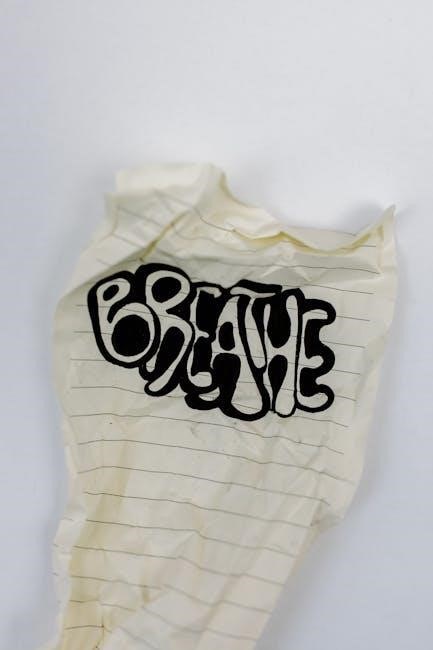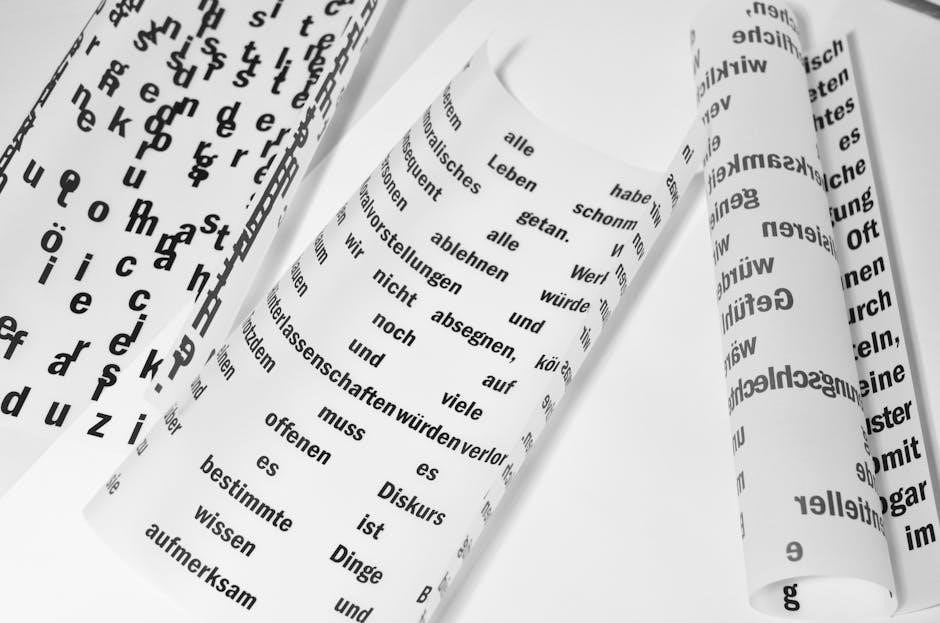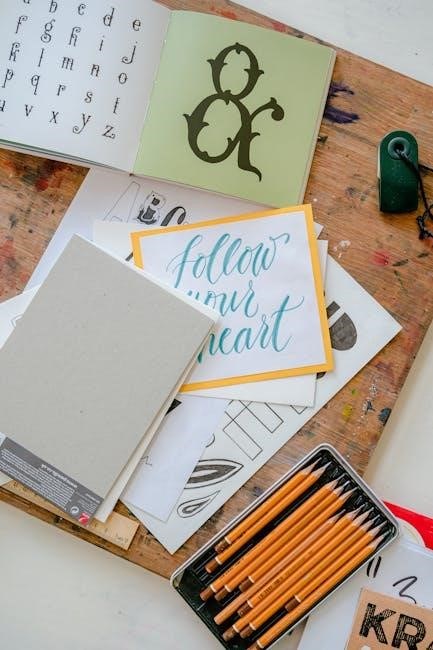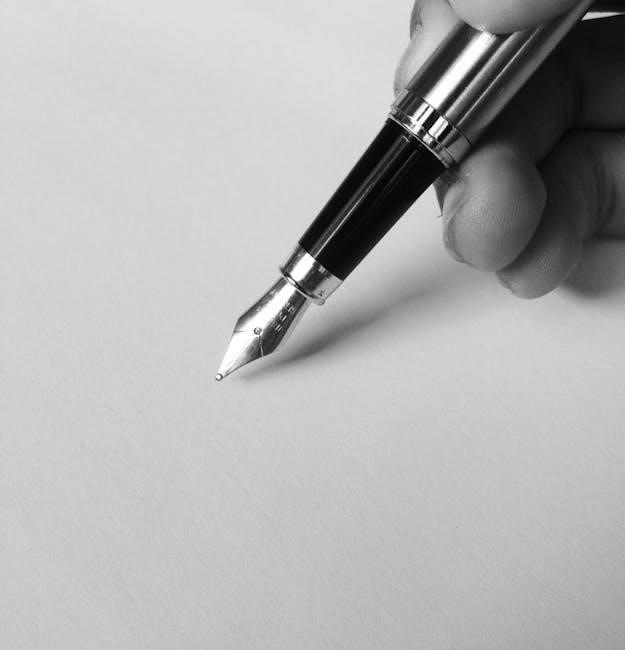Calligraphy guide sheets are essential tools for mastering lettering, providing templates for consistent spacing, alignment, and style. They help beginners and professionals alike achieve precise strokes and uniformity. Use with ink, nibs, and paper for best results.
History and Evolution of Calligraphy Guide Sheets
Calligraphy guide sheets have a rich history, tracing back to ancient civilizations where lettering was a revered art form. Early examples were hand-drawn on parchment or vellum, serving as templates for scribes to maintain consistency in scripts like Latin, Greek, and Chinese calligraphy.
During the Middle Ages, monks used guide sheets to replicate religious texts, ensuring uniformity in illuminated manuscripts. The Renaissance brought advancements in printing, allowing mass production of guide sheets, which became indispensable for calligraphy enthusiasts.
The Industrial Revolution further popularized guide sheets through mechanized printing, making them accessible to hobbyists and professionals alike. Today, guide sheets are used globally, adapted for various languages and styles, from traditional copperplate to modern brush scripts.
Digital tools now complement physical guide sheets, offering customizable templates and practice aids. Despite technological advancements, the timeless appeal of guide sheets endures, preserving the art of calligraphy for future generations.


Types of Calligraphy Guide Sheets
Calligraphy guide sheets vary widely, catering to different scripts and styles. Common types include copperplate, brush, and gothic guides, each offering unique line spacing and lettering templates. They also come in various sizes and grid layouts.
Guide Sheets for Different Languages and Scripts
Calligraphy guide sheets are tailored to accommodate various languages and scripts, ensuring proper letter formation and spacing. For instance, Arabic calligraphy guide sheets feature intricate floral patterns and geometric designs, while Chinese and Japanese guides emphasize brush stroke precision. Latin script guides often focus on serif and sans-serif styles, catering to both modern and traditional calligraphy. Additionally, guide sheets for languages like Devanagari (Hindi) or Cyrillic incorporate specific lettering rules unique to those alphabets. These sheets are adaptable to different writing systems, making them versatile tools for calligraphers worldwide. They also support historical scripts, such as Gothic or Uncial, allowing artists to explore diverse cultural influences. By providing standardized templates, guide sheets help maintain consistency and accuracy, whether for decorative art, formal invitations, or educational purposes. This adaptability ensures that calligraphy guide sheets remain indispensable for practitioners across languages and styles.
Guide Sheets for Various Calligraphy Styles
Calligraphy guide sheets are designed to cater to a wide range of styles, from traditional to modern. For Copperplate and Spencerian scripts, guide sheets often feature fine lines to help achieve the delicate flourishes and precise letterforms characteristic of these styles. Brush Script and Modern Calligraphy guides include spacing and slant markers to ensure fluid, contemporary lettering. Additionally, styles like Gothic or Blackletter benefit from guide sheets with bold, dark lines to emphasize the dramatic contrast of thick and thin strokes. Each style-specific guide sheet is tailored to the unique requirements of the script, such as letter proportions, spacing, and decorative elements. This customization allows calligraphers to maintain consistency and precision, whether they are creating formal invitations, artistic pieces, or practicing basic lettering. By providing a structured framework, guide sheets empower artists to master various calligraphy styles with confidence and accuracy.
Materials Needed for Using Calligraphy Guide Sheets
To get started with calligraphy guide sheets, you’ll need a few essential materials. First, high-quality guide sheets are a must, as they provide the templates and spacing guides for your lettering. Choose paper that is smooth and suitable for ink, such as hot-pressed watercolor paper or vellum. Calligraphy ink, like Higgins or McCaffery’s, is ideal for bold, vibrant lines. A dip pen or a fountain pen with interchangeable nibs is also necessary, as different nibs create varying line widths and styles. Additional tools include a light box or a sunny window for tracing, a pencil for sketching, and an eraser for corrections. A ruler or straightedge can help align your work, and a practice pad is useful for warming up. Optional items like gouache or metallic inks can add creativity to your designs. Gather these materials to ensure a smooth and enjoyable calligraphy practice with guide sheets.
Step-by-Step Guide to Using Calligraphy Guide Sheets
Using calligraphy guide sheets is a straightforward process that helps you achieve professional-looking lettering. Start by placing the guide sheet on a flat surface and positioning your paper over it. Secure both with clips or tape to prevent shifting. Next, select your pen or nib, ensuring it’s properly inked. Begin by tracing the guidelines lightly with a pencil to mark the spacing and alignment. Then, carefully draw over the pencil marks with your pen, following the strokes indicated on the guide sheet. Pay attention to letter spacing and height consistency. Once complete, allow the ink to dry before handling the paper. For more intricate designs, layer additional guide sheets or use different nibs for varying line widths. Practice regularly to build muscle memory and improve accuracy. By following these steps, you can master calligraphy with ease using guide sheets.

Benefits of Using Calligraphy Guide Sheets
Calligraphy guide sheets offer numerous benefits for both beginners and experienced calligraphers. They provide a structured template, ensuring consistency in letter spacing, alignment, and height, which is crucial for creating professional-looking results. For newcomers, guide sheets simplify the learning process by breaking down complex letterforms into traceable outlines, helping to build confidence and skill. They also save time by eliminating the need to measure and mark spacing manually. Additionally, guide sheets are versatile, accommodating various scripts and styles, from modern brush lettering to traditional copperplate. They are particularly useful for practicing different languages and alphabets, as they often include specific guidelines for unique character sets. Moreover, guide sheets allow for experimentation with different tools and inks without the risk of ruining expensive paper. Overall, they are an invaluable resource for mastering calligraphy, fostering creativity, and achieving precise, elegant lettering with ease.

Customizing Your Calligraphy Guide Sheets
Customizing calligraphy guide sheets allows you to tailor them to your specific needs, enhancing your practice and creativity. You can adjust spacing, line height, and baseline alignment to suit your preferred script or style. For instance, adding grid patterns or flourishes can help achieve intricate designs. Many artists incorporate guidelines for different languages or alphabets, ensuring accuracy in diverse scripts. Digital tools enable you to create personalized templates, while printed sheets can be modified with overlays or tracing paper. Customization also lets you focus on problem areas, such as letter spacing or slant consistency. By adapting guide sheets to your projects, you can refine your technique, explore new styles, and maintain precision. This flexibility makes guide sheets invaluable for both learning and mastering calligraphy, ensuring your work remains unique and polished.

Common Mistakes to Avoid When Using Guide Sheets
When working with calligraphy guide sheets, several common mistakes can hinder progress. One of the most frequent errors is ignoring proper alignment, leading to uneven letters. Ensure your guide sheet is straight and securely fastened. Another mistake is using the wrong nib size for the template, causing strokes to appear disproportionate. Additionally, neglecting to practice basic strokes before moving to complex scripts can result in inconsistent lettering. Many beginners also overlook the importance of maintaining consistent pressure and angle with their nib, which is crucial for uniform lines. Furthermore, failing to leave adequate space between letters and words can make text appear cramped. It’s also easy to rush through practice, so take your time to focus on precision. Finally, not warming up with simple exercises before diving into intricate designs can lead to stiffness in your strokes. By being mindful of these pitfalls, you can maximize the effectiveness of your guide sheets and improve your calligraphy skills more efficiently.

Advanced Techniques for Mastering Calligraphy with Guide Sheets
Mastering calligraphy with guide sheets involves refining your skills through advanced techniques. One such method is layering, where you build up strokes gradually to achieve depth and texture. Experimenting with different nib sizes and ink flows can also enhance your work. For instance, using a flexible nib allows for varying line widths, adding dynamism to your letters. Another advanced technique is incorporating flourishes and decorative elements, which require precision and control. Practicing these embellishments with guide sheets helps maintain consistency. Additionally, blending different scripts or styles within a single piece can create unique and visually striking designs. To take your calligraphy to the next level, focus on perfecting spacing and alignment, as these are critical for professional-looking results. Regular practice with guide sheets will help you develop muscle memory and improve your overall craftsmanship. By pushing the boundaries of traditional techniques, you can unlock new creative possibilities in calligraphy.

The Role of Guide Sheets in Modern Calligraphy
In modern calligraphy, guide sheets remain indispensable for maintaining precision and consistency. They serve as a foundation for both beginners and professionals, ensuring uniform lettering and spacing. With the rise of digital tools, guide sheets have evolved to include customizable templates, catering to various styles and scripts. Many artists use them to experiment with new techniques while preserving traditional methods. Guide sheets also play a crucial role in workshops and classes, helping students master intricate letterforms. Their versatility allows adaptation to different surfaces and materials, making them a timeless resource in the digital age. By providing a structured framework, guide sheets empower calligraphers to focus on creativity and expression, ensuring their work remains refined and professional. Whether for personal projects or commercial designs, guide sheets continue to be a cornerstone of modern calligraphy practice.
How to Create Your Own Calligraphy Guide Sheets
Creating custom calligraphy guide sheets allows for personalized practice tailored to your needs. Start by deciding on the size and layout, considering standard dimensions for versatility. Use a ruler or digital tools to draw straight lines, ensuring precision. Include dashed lines for spacing and solid lines for writing, along with margin guidelines for alignment. Choose appropriate paper, such as regular for practice or cardstock for durability, and consider laminating for protection against ink. Customize templates for different calligraphy styles, like copperplate or brush script. Utilize online templates as a starting point and adjust them to suit your preferences. Ensure clear, high-contrast lines for visibility. Add features like rulers or sample text for reference. For reusability, use a light pad to trace lines without marking the guide. Organize your sheets in a folder or binder for easy access. With careful planning, you can craft guide sheets that enhance your calligraphy practice and skill development.
Tips for Practicing Consistently with Guide Sheets
Consistent practice with calligraphy guide sheets is key to improving your skills. Start by setting aside a specific time each day, even if brief, to practice. Begin with warm-up exercises, such as tracing lines and basic strokes, to build muscle memory. Use a variety of tools, like nibs and brushes, to explore different effects. Focus on one style or script at a time to master it before moving on. Incorporate guide sheets into your routine to maintain uniformity in spacing and alignment. Gradually increase the difficulty of your practice as you progress. Keep a journal to track your improvement and identify areas for refinement. Stay relaxed and patient, as calligraphy is a meditative process. Experiment with different inks and papers to enhance your experience. Finally, make practice enjoyable by incorporating personal projects, like creating art or writing quotes. Regular dedication will lead to noticeable growth in your calligraphy abilities.

The Importance of Alignment and Spacing in Guide Sheets
Alignment and spacing are fundamental aspects of calligraphy, and guide sheets play a crucial role in achieving these elements. Proper alignment ensures that letters and words are evenly distributed, creating a visually appealing and professional appearance. Spacing, both between letters and lines, is equally important for readability and aesthetic balance. Guide sheets provide pre-drawn grids and baselines, helping practitioners maintain consistency in their work. Without proper alignment, text can appear disorganized and amateurish, while incorrect spacing can make it difficult to read. By using guide sheets, calligraphers can focus on the artistic aspects of lettering while ensuring structural integrity. This is especially important for beginners, as it helps build good habits and a strong foundation. Over time, consistent practice with guide sheets enhances the ability to judge alignment and spacing intuitively, leading to more confident and precise work. Thus, alignment and spacing are not just technical details but essential components of mastering calligraphy.
Using Guide Sheets for Different Surfaces and Papers
Calligraphy guide sheets are versatile tools that can be used on various surfaces and papers, but the choice of material significantly impacts the outcome. Smooth, high-quality papers, such as Bristol board or hot-pressed watercolor paper, are ideal for calligraphy as they allow ink to flow evenly and prevent feathering. Guide sheets can be placed underneath these papers to ensure alignment and spacing consistency. For textured or rough surfaces, such as cold-pressed watercolor paper, the guide sheets still provide a helpful framework, though the ink may spread slightly more. Additionally, guide sheets can be used on alternative surfaces like parchment or vellum for unique, traditional effects. When working with different papers, it’s important to adjust nibs and ink flow accordingly to maintain precision. Experimenting with various surfaces and papers while using guide sheets can enhance creativity and mastery in calligraphy. Proper surface preparation and paper selection are key to achieving professional-looking results.
The Future of Calligraphy Guide Sheets in the Digital Age
Calligraphy guide sheets are evolving in the digital age, blending traditional techniques with modern technology. Digital tools now offer customizable guide sheets, allowing artists to create personalized templates for various scripts and styles. Apps and software enable precise adjustments, making it easier to achieve consistency. Additionally, digital guide sheets can be projected onto surfaces, simplifying alignment on large or complex projects. While traditional physical sheets remain popular, digital versions provide unparalleled flexibility and convenience. This fusion of old and new ensures that calligraphy guide sheets remain relevant and accessible to future generations of artists. The rise of digital platforms also fosters collaboration, with shared templates and tutorials spreading globally. As technology advances, the possibilities for calligraphy guide sheets continue to expand, offering innovative ways to practice and master this timeless art form.

Conclusion and Final Thoughts on Calligraphy Guide Sheets
Calligraphy guide sheets remain indispensable tools for mastering the art of lettering, offering precision, consistency, and creativity. Whether for traditional scripts or modern styles, they provide a foundation for achieving beautiful results. Their versatility across languages, surfaces, and techniques ensures their relevance in both analog and digital environments. While technology advances, the timeless appeal of guide sheets endures, making them a valuable resource for artists of all levels. By combining practice, patience, and the right materials, calligraphers can unlock their full potential with these essential aids. As calligraphy evolves, guide sheets will continue to play a central role, bridging tradition and innovation. They are not just tools but gateways to artistic expression and mastery.
